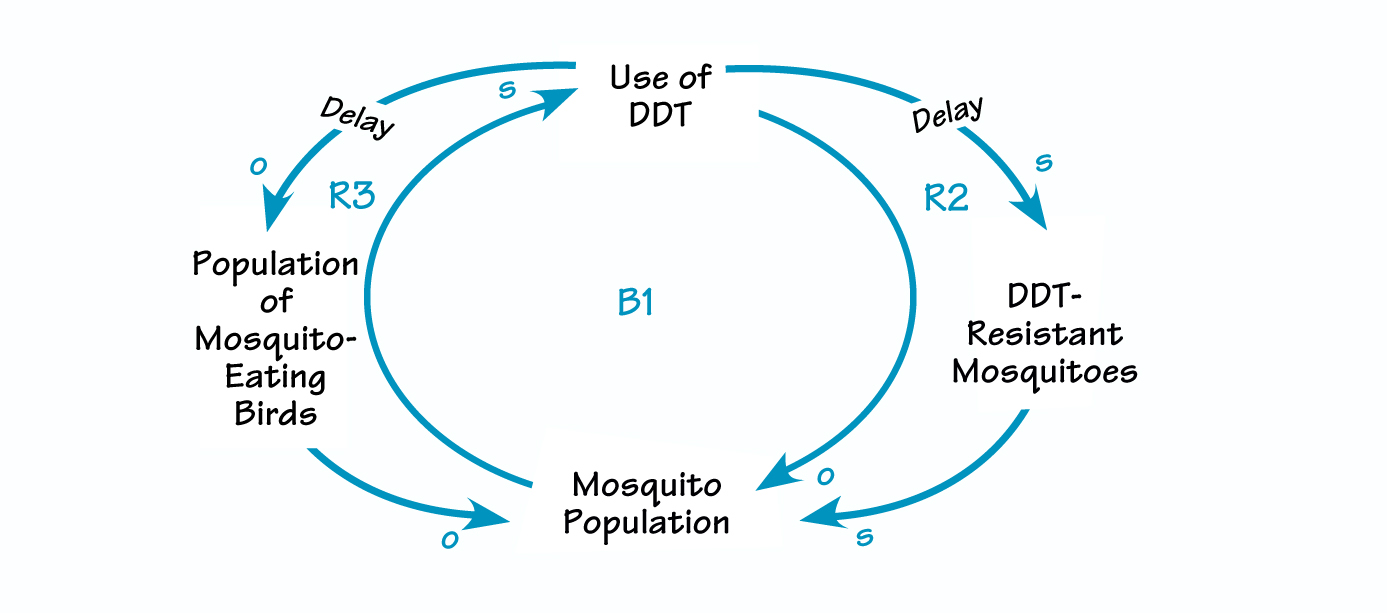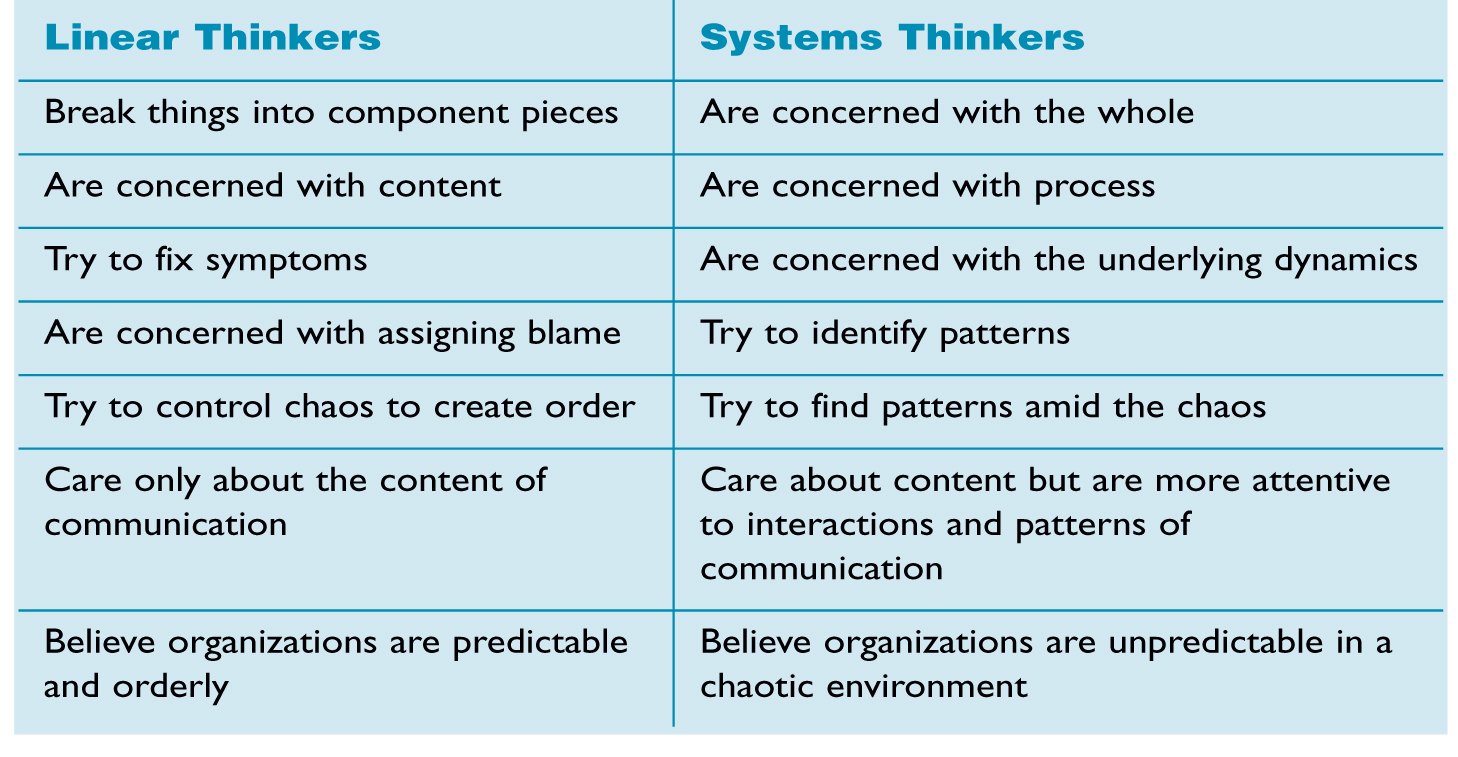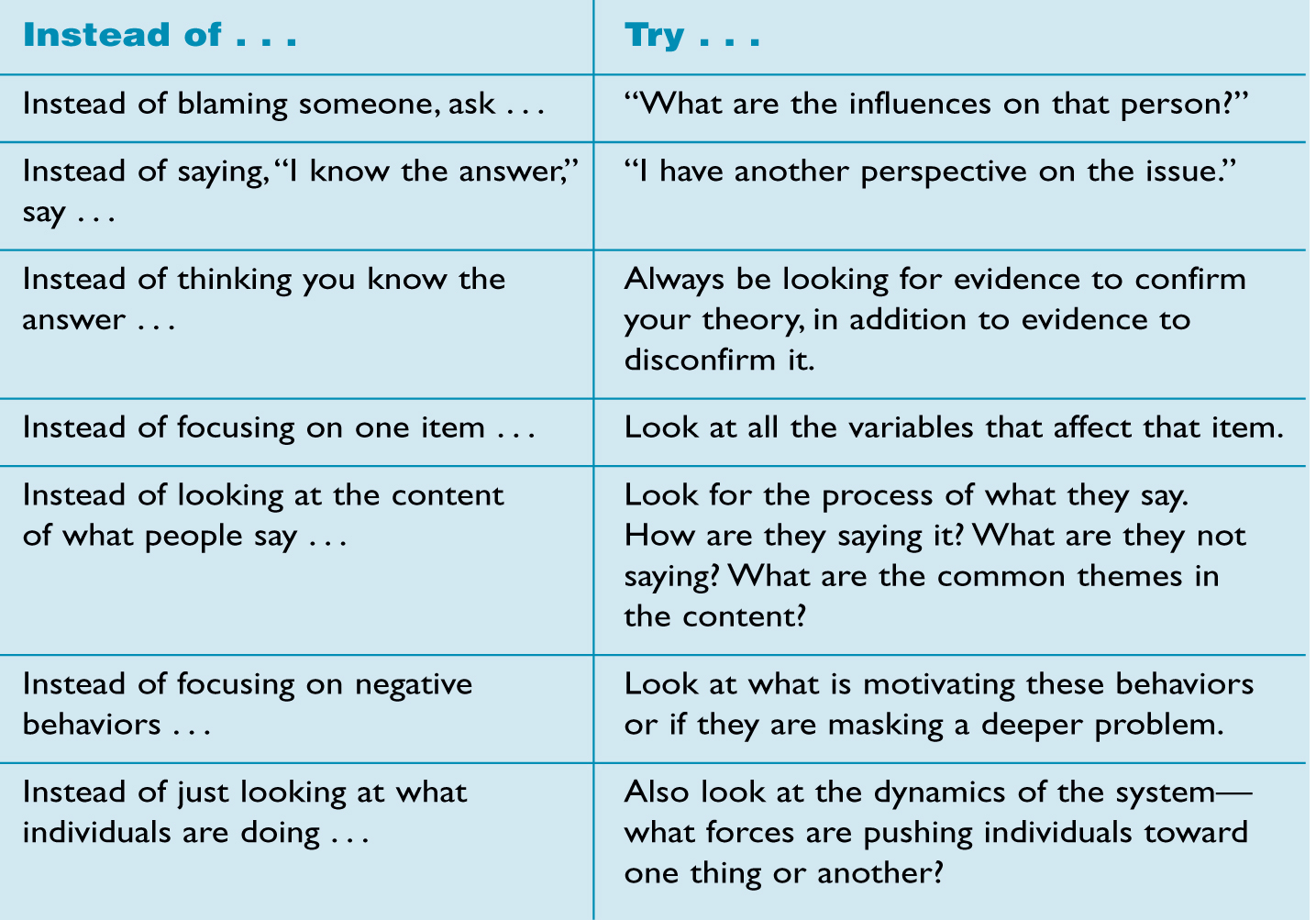When Albert Einstein began to play with the theory of quantum physics, he didn’t like it. He spent a few years trying to disprove it, because it didn’t make sense to him. But in the end, Newtonian physics couldn’t answer Einstein’s questions. His only choice was to become a quantum thinker. This didn’t mean that he rejected Newtonian physics entirely; it simply meant that there were many occasions when he had to use a quantum rather than a Newtonian approach.
People don’t become systems thinkers because systems thinking is so cool; they do so because they discover that linear thinking won’t answer their questions. Linear thinking is cause-and-effect thinking: One cause has one effect. Sometimes it works adequately, as when you run out of gas and your car stops. Your car stopped (effect) because it had no gas (cause). If you put gas in again, your car will run. Linear thinking is quite effective in solving this kind of problem.
TEAM TIP
So many of the interventions we design focus on addressing symptoms rather than underlying problems. Use the clues in “Is It a Problem or a Symptom?” to determine whether your actions are merely bandaids or are likely to have a lasting, positive impact.
However, our world is made of many complex relationships and interrelationships. Systems thinking provides a perspective that, most of the time, various components affect each other in various, and often unexpected, ways. So, for example, the use of the pesticide DDT to kill mosquitoes led to a number of unanticipated side effects. These included the decimation of several species of mosquito-eating birds and the rise of DDT resistant mosquitoes. Over time in some places, this dynamic made the mosquito problem worse (see “Unintended Consequences of DDT”). In organizations, systems thinking brings powerful tools and enlightened perspectives to organizational diagnosis, problem solving, strategy, and leadership (see “Linear vs. Systems Thinking”).
UNINTENDED CONSEQUENCES OF DDT

LINEAR VS. SYSTEMS THINKING

The Road to Becoming a Systems Thinker
Adopting a systems approach takes persistence and curiosity. Being the sole systems thinker in a linear thinking organization can be a lonely place. People will not understand you. You’ll feel like you’re walking around with two heads… whenever you talk, people will stare at you, confused.
Of course, many people have thought systemically all their lives. Many of them don’t even know that what they are doing is labeled “systems.” But for the vast majority of us, the jump to systems thinking requires time, practice, curiosity, and intentionality (see “Making the Shift”).
MAKING THE SHIFT

Is It a Problem or a Symptom?
One way to start to shift from linear to systems thinking is to practice identifying whether something is the problem or merely a symptom of something deeper. Linear thinking tends to focus on addressing surface-level behaviors – or symptoms. Unfortunately, making a symptom go away won’t solve the problem. In fact, it may make things worse and cause effects in other parts of the organization. A manager taking a systems thinking approach will work to understand the underlying problem before addressing any of the symptoms. Usually, if the true problem is solved, the symptoms will be eliminated as well.
How do you know if you’re seeing the real, underlying problem or simply a symptom of something deeper? Below are eight clues that what you are experiencing is an indicator of a larger problem rather than the problem itself:
-
- The Size of the Problem Isn’t Commensurate with the Discussion Around It.
Is the problem too small in comparison to the time and energy it is taking? If people are spending all their time, for example, complaining about the color of the carpet or the shape of their offices, you can assume that their reaction is a symptom of another problem.
- People Don’t Solve a Solvable Problem. Is it within the power of the people in your organization to solve the problem, but they don’t? For example, people complain there is no decaffeinated coffee, but no one does anything about it. Why don’t they feel empowered to change the status quo?
- The Problem Won’t Go Away. What has the history of the problem been? Is it something that won’t go away? Have you tried to solve it and have been unsuccessful? Does it keep coming back, like a monster in a horror movie? Does the problem morph into a related issue once you “solve” the original issue? Generally speaking, if you “solve it” and it comes back, then you haven’t addressed the underlying problem.
- The Problem Involves Emotional Barriers. In the middle ages, prior to Christopher Columbus, mariners were afraid to sail south of the equator. Contrary to popular belief, they weren’t afraid of falling off the edge of the world. (The ancient Greeks had proven that the world was round in about 500 B. C.) They were unwilling to do it because it hadn’t been done before. Sailors never even considered it a possibility. As such, it was an emotional barrier, a product of stunted imagination. The same kinds of emotional barriers are present in today’s organizations. What are the things that are never talked about? What are the things that, if someone mentions them, people laugh them off? Where is the imagination stunted in your organization?
- The Problem Has a Pattern. Does the problem have an annual cycle? Is it predictable? If so, it may be a symptom of something deeper.
- The Organization Has Kept the Problem Around, like a Pet. In a healthy organization, if a problem arises, people solve it once and for all. Unhealthy organizations need problems because they give people something to focus on and fuss about. No one consciously tries to keep the problem, and everyone says they want to solve it. However, even though we may not be aware of it, we manage to keep the challenges we like!
- Other Stresses and Anxieties Are Present in the Organization. The more anxiety in an organization, the more likely it is that real problems are hidden, manifested only in symptoms. For example, in companies with a domineering culture, employees can feel victimized by management. Most people, when feeling victimized, will complain about other things rather than reveal their true feelings. The more stresses that are present, the more likely there will be a variety of seemingly unrelated symptoms.
- As One Problem Is “Solved,” Another Crops Up. In an organization that relies on reactive, quick-fix, cause-and-effect management, once one problem is solved, another tends to crop up. Most linear thinkers won’t realize that the two issues are related. Meanwhile, the underlying dynamics fueling the problems fail to be addressed.
Ten Enemies of Systems Thinking
The ten statements below are usually evidence of linear thinking and, thus, enemies of systems thinking. Hearing them is not always a sure-fire guarantee that linear thinking is coming, but they should set off warning bells.
- We’ve got to fix it quick! This is the proverbial “quick-fix” mentality. We see a problem, and we react to fix it before we really understand it. There is nothing wrong with quick, assertive action, and a systems response to a problem is not necessarily slow. But doing the fix before grasping the problem is a recipe for disaster.
- “Oh, let’s just put a bandage on it.” The bandage solution is often a half-hearted attempt to fix a problem. The danger is that it can cover up the worst of the symptoms while allowing the problem to continue to fester.
- “We must make the budget by the end of the fiscal year!” Budgets are notoriously linear. They force us to make decisions based on money rather than on whether the idea is good. In particular, making a decision to fix something so we are “in the black” by an arbitrary deadline is problematic. While being profitable is desirable, last-minute Herculean efforts to reach monetary targets are the antithesis of systemic thinking. Short-term quick fixes almost always harm long-term sustainability.
- “We need to respond immediately!” Knee-jerk reactions and panic attacks, borne out of anxiety and learned helplessness, create linear solutions. A calm, reasoned strategy offers a more systemic way to address a situation. This does not mean acting slowly; it means taking a moment to consider the different variables that contribute to a situation.
- “Who cares?” An apathetic approach, or a plain lack of curiosity, is a barrier to effective problem solving. Curiosity, play, imagination, and adventure are the antidotes to stuck organizations.
- “We need more information.” There is nothing wrong with seeking more information, unless we believe it will solve the problem for us. Additional data is good when we know its place. We – not information -have the power to act. And we – not information – must have the courage to do so.
- “Oh, you’re just thinking too much.” Shallow and superficial thinking is everywhere – just watch the nightly news. All of the complex problems of the world are boiled down to a few sound bytes. The accusation of “thinking too much” usually means “Stop thinking differently from me.” The reality is that systems thinking is a new kind of thinking, and not everyone likes to stretch in new ways.
- “To hell with the rest of the organization; we must get our own needs met.” Many people in organizations hold this kind of fortress mentality. In our companies and schools, we live in bunkers, protecting our own needs and the resources of our unit. Consequently, we end up thinking of win-lose strategies and strategizing about how to get more for ourselves. This approach is classic linear thinking.
- “We can’t have any conflict.” Some of us will do anything to keep the peace in our organizations. Edwin Friedman calls this “peace-mongering.” Peace-mongers will avoid, suppress, and mask conflict, at the expense of discussing and addressing real issues.
- “You will do it this way, and you will enjoy it!” Authoritarian managers who force their will on the workforce are prime examples of linear thinkers. Wisdom is collaborative, and domineering interventions undermine innovation, collective problem solving, and creativity.
Systems thinking is easy for some and difficult for others. Some people intuitively think in systems terms and have done so their entire lives. However, most people today think in linear, reductionistic, and mechanistic terms.
At first when people start thinking in systems, they can find things to be a bit chaotic. They become overwhelmed by the number of variables and think, “How can I do anything if I don’t know what effect my intervention will have?” This kind of thinking is normal and usually gives way to a sense of deeper insight as an individual begins to learn various principles of systems behavior. We hope the ideas in this article offer a first step toward that kind of understanding.
Jim Ollhoff (jim@ollhoff.com) is a college professor, with an academic background that includes training in education, family studies, developmental psychology, social psychology, and systems theory. His academic interests are the process of discovery in anxious systems, effective management from a complexity perspective, leadership, strategy, and adult learning. Jim teaches courses in the areas of family studies and in management.
Michael Walcheski is the chair of the Department of Family Studies at Concordia University, St. Paul, Minnesota. He has a PhD in Marriage and Family Therapy and is a licensed marriage and family therapist.
